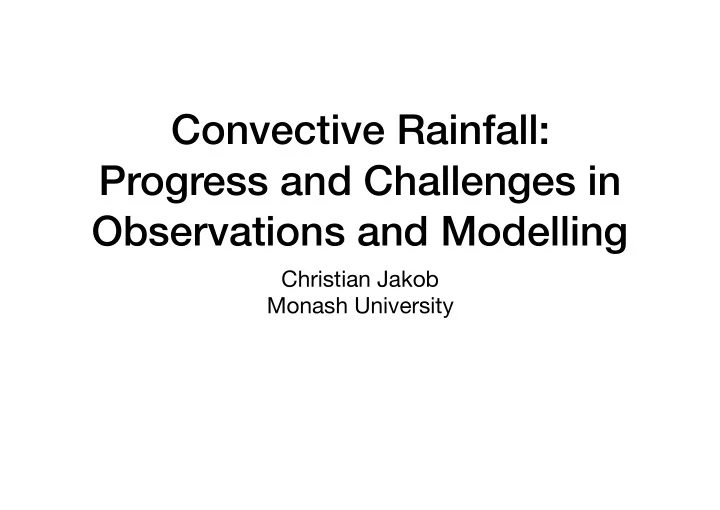

Convective Rainfall: Progress and Challenges in Observations and Modelling Christian Jakob Monash University
Convection, the ITCZ and modelling it all Christian Jakob Monash University The work was really done by: Leonore Jungandreas, Evan Weller, Jackson Tan, Vickal Kumar, Valentin Louf, Karsten Peters and Benjamin Möbis
The “tropics” are close to Radiative Convective Equilibrium (RCE) pretty much every day, but the ITCZ is not (not even on average)! How does this work, and what does it mean? Daily mean radiative cooling vs precipitation averaged from 30N to 30S
We define a “distance from RCE” as the difference between radiative cooling, sensible heat flux, and precipitation and ask what fractions of days are in RCE (-50 to + 50 W/m2 difference) as a function of spatial and temporal averaging scale.
In relating RCE to cloud states, we find that achieving RCE requires the “right” mix of deep and organised convection and suppressed conditions. ST
The ratio of active to suppressed conditions appears to be quite scale- invariant. Snapshots 20x20 70x70
Implications for modelling and climate change More rainfall implies a need for more radiative cooling or an increase of the energy transport out of the tropics. Hence, rainfall errors in models must be accompanied with errors in their radiative cooling elsewhere. Most models overestimate rainfall in the tropics, so they also must overestimate radiative cooling or lateral energy export. High cloud errors will induce radiative cooling errors, which in turn must relate to precipitation errors! Analysing climate model rainfall to cooling relationship should be very revealing. (I am looking for a student to do this!) Rainfall increases under climate change will imply changes to the radiative cooling. This is most likely achieved through area changes (shrink the ITCZ or widen the sub-tropics).
The ITCZ is not a steady line of convergence. Instead it is the average of many short-lived convergence features that locally are relatively rare and strongly vary on synoptic time-scales. Snapshot of convergence lines and rain Annual mean frequency of convergence lines with L > 300 km Weller et al, JCL 2017; Data set: ERA Interim
While convergence lines are relatively infrequent, most of the rainfall in the ITCZ is associated with them. The amount of rain is well correlated with the strength of the line, which in turn is related to its length Percentage of annual mean rain associated with convergence lines Relationship of convergence line strength (and length) to rainfall Weller et al, JCL 2017; Data sets: ERA Interim and CMORPH
Much of what has become known as the “dynamical” component of precipitation climate change is a change in frequency and strength of the short-lived convergence lines that dominate ITCZ rainfall. Units - % of control Units - mm/day Weller et al, submitted; Data sets: CMIP5
As much of the rainfall in the ITCZ is associated with synoptically varying convergence lines, models must simulate these features as well as their association with rainfall well. Weller et al., GRL, 2017
Despite the significant variability in convection on many scales, snapshots of ISCCP-based convective regimes show coherent features at large scales Tan et al., JGR, 2015
Diagnostic models - even when they are “machine- learned” - will not capture this coherence as the stochasticity in the relationship to the larger scales will destroy any structure. Observed (dashed) and modelled (solid) lifetime of convective regimes using a stochastic diagnostic model. Tan et al., JGR, 2015
Making the models prognostic makes a huge difference as it provides a smooth time evolution that is much more congruent with the synoptic time scales of the larger scale motions. Observed (dashed) and modelled (solid) lifetime of convective regimes using a stochastic prognostic model. Tan et al., JGR, 2015
There are many issues on modelling convection in GCMs, both at the overall results level and the internal working of the schemes • No co-existence of different types of convection • No convective organisation • Relationships to large-scale are assumed to be deterministic • Local in space and time (no memory, no propagation) • Poor microphysics • No physically justifiable way to deal with variable resolution of the host model • Lots of idiosyncrasies that now determine the results more than the actual physics. We require an entirely new paradigm on how we develop physics - and not just convection!
Convective rainfall in an area of the size of a GCM grid box is strongly related to the size of the area that is convecting! 16 years of data Radar analysis from 16 wet seasons in Darwin
This opens opportunities for new approaches to convection parametrisation that focus on predicting the convective area and velocity instead of just mass flux. GCM grid O(100 km) O(1 km) Deep convection Congestus Physical model Shallow Cold Pools Statistical model SMCM grid Deep convection Congestus Shallow Cold Pools
Summary • Many scales matter in setting the ITCZ properties. • For its mean properties, the precipitation-cloud-radiation coupling is something we may want to pay more attention to. • Convergence lines are involved in much of the shorter time-scale dynamics. • Diagnostic convection models do not work - New approaches are required and they need to be prognostic and have stochastic elements. • This opens up new opportunities for the representation of convection specifically and atmospheric physics in general.
Recommend
More recommend